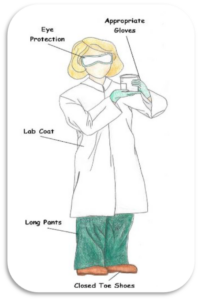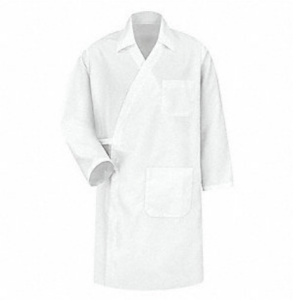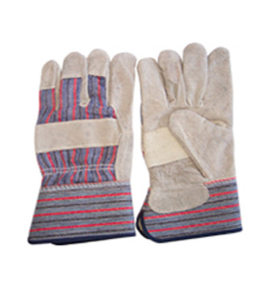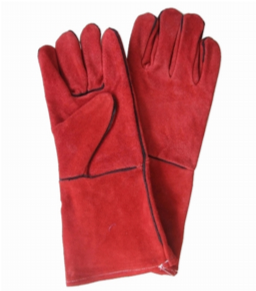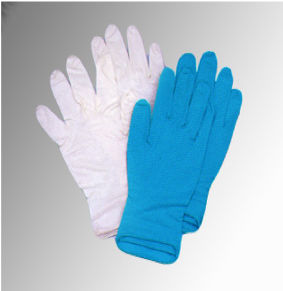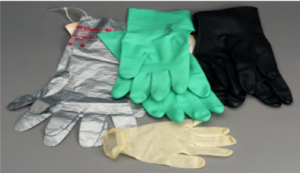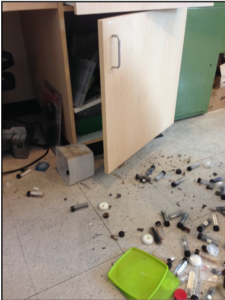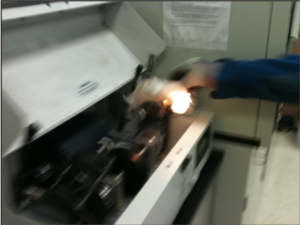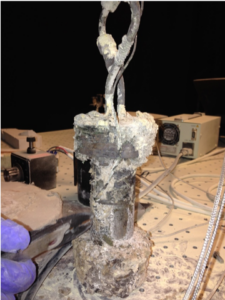LAB SAFETY AND HAZARDOUS WASTE TRAINING
Estimated duration: 60 minutes.
This training is required for all lab users one-time before conducting work in a laboratory in order to:
- Gain an understanding of the principles of lab safety
- Be able to recognize, assess and avoid common lab hazards
- Become familiar with lab control measures (e.g. lab hoods) and personal protective equipment
- Be prepared to respond to emergencies in the lab
Please visit Mines EHS website before continuing to Module 1.
Module 1: Proper Dress and PPE
Watch
Read
Personal Protective Equipment (PPE)
Proper dress (long pants, closed toe shoes, lab coat, safety glasses, and gloves) is required at ALL times in laboratories and workshops at Mines. Dangling jewelry and long hair can get caught in moving machinery, or can get in the way of safely conducting lab or workshop activities. Always tie up long hair, and remove dangling jewelry.
|
Proper PPE |
Improper PPE |
Improper PPE |
Lab Coats
|
Barrier Lab Coat |
Traditional Lab Coat |
Flame Resistant Lab Coat |
Lab coats provide a critical barrier between you and the hazards in your lab. Lab coats provide protection against incidental contact and small chemical splashes, and are a removable barrier in the event of an emergency or to prevent contaminated clothing leaving the lab. Depending on what hazards you work with, you will need to select the correct lab coat.
Barrier lab coats are made of polyester and provide splash protection and are often worn in biological labs. These coats are often impermeable to liquids, which offers splash protection. However, due to a lack of breathability in the fabric, these coats can be uncomfortable to wear for long periods of time.
Traditional lab coats should be made of a poly/cotton blend. These coats are comfortable to wear and provide incidental protection for splashes and contamination. They should not be used with pyrophoric materials or open flames.
Flame resistant (FR) lab coats offer the highest level of fire protection and should always be worn when using pyrophoric, spontaneously combustible, or large volumes of flammable chemicals.
Eye and Face Protection
 |
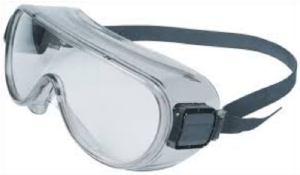 |
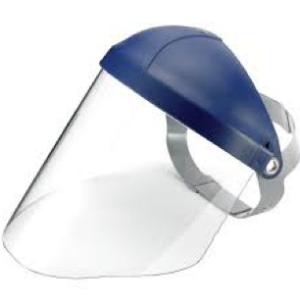 |
 |
 |
| Safety Glasses Required to enter a lab or machine shop; Protects against debris or objects hitting your eyes |
Splash Goggles Required when working with hazardous chemicals; Protects your eyes from chemical splashes |
Face Shield Protects your entire face from debris, objects, or chemical splashes; Worn with safety glasses or splash goggles |
Laser Glasses Protects your face and eyes from laser activities; Additional training required |
Welding Helmet Protect your face and eyes from welding activities; Additional training required |
Safety glasses are required, at a minimum, at all times in labs and workshops. When pouring or working with chemicals, splash proof goggles or a face shield are recommended.
Hand Protection
|
Protection from Physical Hazards |
Protection from Chemical Hazards |
Physical hazards like hot, cold, and sharp edges can be avoided using the right kind of glove. Make sure to identify the appropriate glove for your physical hazard. Physical hazard gloves include: insulated cryogenic gloves, leather cut resistant gloves, and heat resistant gloves.
Chemical resistant gloves come in many different types. Chemical resistant gloves do not protect you from every chemical. Use a chemical glove selection guide (links below) to help choose the right glove for your chemicals.
Module 2: Safety Equipment and Emergency Response
Watch
Read
Safety Equipment: Laboratory Hoods
Laboratory fume hoods protect against inhalation of chemicals, as well as offer some splash protection when the sash is lowered. In this section, we discuss how to ensure your lab hood is working, and some guidelines to help you work safely in a lab hood.
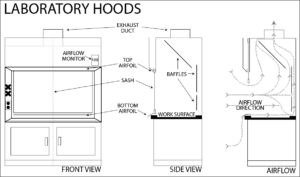 |
| Figure: Illustration of the components and airflow patterns of a lab hood. |
The figure above highlights some of the important components of laboratory hoods including: the sash, airfoils, baffles, and airflow monitor. The sash is clear, and moves up and down to allow you to work in a hood. Airfoils and baffles enable air to move in the proper direction. Lab hoods pull air in from the laboratory, and expel the airflow up and out of the hood into the building’s exhaust ductwork.
Laboratory Hood Airflow Monitors
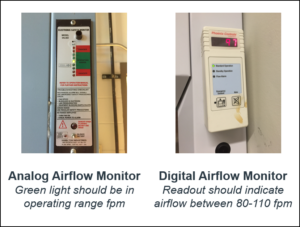 |
| Figure: Images and descriptions of analog and digital airflow monitors. |
Most laboratory hoods at Mines are equipped with an airflow monitor and a visual readout (see figure above). This monitor should indicate between 80 and 100 feet per minute (fpm) or show a green indicator light. If you notice the air flow drops below 80 fpm or an audible alarm is sounding, lower the hood sash, step away from the hood and call EHS or Facilities Management for assistance (303-273-3330).
Laboratory Hood Guidelines
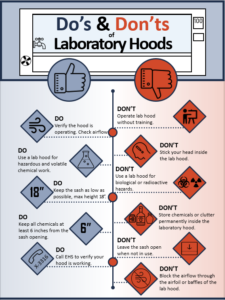 In order for a lab hood to function properly,
In order for a lab hood to function properly,
- work with materials at least six inches from the front of the hood,
- work with the sash as low as possible and close the sash when you’re not using the hood,
- never put your head into a fume hood,
- never store excess chemicals or equipment in the hood,
- and follow the do’s and don’ts of laboratory hoods in the figure above!
Safety Equipment
There is a wide variety of specialty equipment designed to minimize exposure to hazards in the laboratory. It is important that you receive thorough training on the proper use of any equipment in your lab.
Certain activities or chemicals require special safety equipment:
|
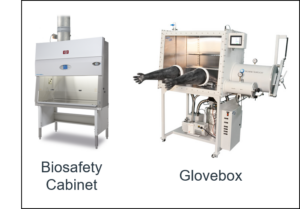 |
Emergency Response
Before you begin work in a laboratory or a workshop, you must identify the locations of emergency equipment. This is the first step to being prepared to handle an emergency. Remember, this equipment may save your life, and you don’t want to be looking for it during an emergency. Plan ahead!
Know where emergency equipment is located:
|
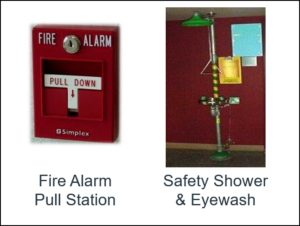 |
Emergency Response: Chemical Exposure and Spills
-
Chemical Contact on Skin or Eyes
- Wash contaminated body parts for 10-15 minutes
- Use safety shower or eye wash station
- Remove contaminated clothing
- Call 911 if you are injured
- Report Incident to your adviser/lab coordinator and EHS
-
Chemical Spill
- Evacuate lab and call EHS at 303-273-3316
- EHS has a spill response team on call 24 hours a day, 7 days a week
- If the chemical spill poses an imminent threat of fire or explosion,
- Pull fire alarm and call 911
- Evacuate lab and call EHS at 303-273-3316
Chemical contact on your skin or eyes can cause very serious injuries. If chemicals are spilled onto your skin, eyes or clothes, you must rinse them off immediately to minimize exposure.
Emergency safety showers and eyewashes are used to rinse chemicals off of you in the event of a chemical exposure and must be available when working with hazardous chemicals. Do not hesitate to use the emergency eyewash (for chemical splashes to your face or eyes), or the safety shower (chemical splashes to your body). Rinse contaminated areas for at least 10-15 minutes. Remove the contaminated clothes and call emergency personnel for help.
EHS will clean up all chemical spills 24 hours a day/365 days a year. In the event of a chemical spill, evacuate the lab, restrict access to the lab and call EHS at 303-273-3316. If the spill presents an imminent threat of fire or explosion, evacuate the lab and pull the fire alarm or call 911.
Emergency Response: Fire
In case of fire, quickly evacuate the building and pull the fire alarm pull station to alert others in the building to evacuate. Call 911 to report the fire and provide details on the location. Remain on the phone until directed to hang up. Golden Fire Department will respond to all fire alarms on campus. Provide any information about the fire to EHS or the Fire Department. Only trained personnel should use a fire extinguisher to put out a fire and only after reporting the fire to 911.
Mines EHS conducts annual fire drills, and has a library of evacuation plans for the academic buildings. Take a look at your building’s evacuation plan HERE.
|
Improper storage of pyrophoric chemicals caused a fire in a Mines lab in 2015 |
Sodium hydride caught fire in a ball mill in a Mines lab in 2012 |
A sublimation chamber caught fire in a Mines Lab in 2014 |
Emergency Response: Incident Reporting
Report all incidents (accidents, injuries, chemical exposures, chemical spills, fires, and near misses) to EHS at 303-273-3316 or EHS@mines.edu. This reporting helps us identify the incident cause and preventative measures while helping to make campus a safer place.
Hazardous Materials Emergency Information Poster
Each lab should have a copy of the EHS Hazardous Materials Emergency Information poster. This poster provides guidance for a number of different laboratory emergencies.
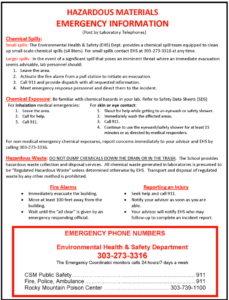
Optional Supplemental Materials
Module 3: Good Lab Behavior
Watch
Read
Food and Drink in the Lab
|
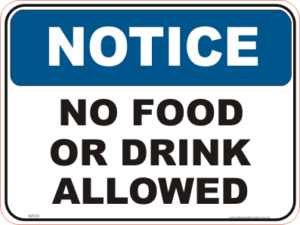 |
Working Alone
Working alone in a laboratory, especially after regular business hours, is incredibly dangerous and should be avoided at all times in laboratories at Mines. Lab personnel are at an increased risk while working alone because they do not have a second person to help in a laboratory accident.
For example, imagine splashing acid or another chemical into your eyes – it would be very difficult to find an eyewash without the aid of another person!
Transporting Chemicals Across Campus
|
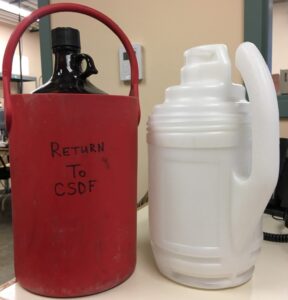 |
Safe Lab Practices
- Ask questions if you don’t know how to do something in the lab
- For example, how to operate a particular piece of equipment in the lab
- Watch out for your fellow lab worker. If you see them about to do something unsafe, give them a heads up.
- Label ALL chemical containers and waste containers
- Include: chemical name(s), concentration, date
- Segregate chemical storage by hazard class (not alphabetically)
- Never work alone (have a buddy system)
- Wash your hands often and when exiting the lab
- Wear proper attire and PPE
- Keep labs clean and clutter-free
- Don’t work in the lab when you’re overly tired or stressed
- Do not prop lab doors open, the doors help maintain proper airflow in the lab and keep unauthorized personnel out of the space.
- Post an “experiment in progress” sign with your name and phone number at your experimental set up
- Maintain access to emergency equipment, paying particular attention to sink mounted eyewash stations
Module 4: Chemical Hazards
Watch
Read
Identify and Assess Hazards
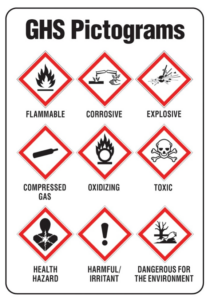 |
Before using chemicals in the lab:
Contact EHS with any questions. EHS can provide chemical specific training including:
|
Globally Harmonized System (GHS)
Be sure to read and understand the labels for the chemicals you work with in your lab. The Globally Harmonized System for classifying and labeling chemicals is a standardized system to help communicate the hazards of chemicals across the world. Every hazardous chemical must be labelled with the applicable universal pictograms that illustrate hazards (see the picture above). Additionally, chemicals must be labelled with a signal word – either DANGER or WARNING. DANGER is used for chemicals with a severe hazard, while WARNING is used for chemicals with less severe hazards. For more information on a chemical, make sure to read a Safety Data Sheet (SDS), see the section below for more information.
Example of a GHS Chemical Label:
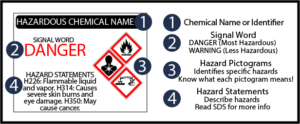
Safety Data Sheet (SDS)
Safety data sheets (SDS) list information relating to occupational safety and health for the use of chemicals. SDS information will include instructions for the safe use and potential hazards of the chemical.
What’s in an SDS?
- 16 Sections of Information:
- Product information
- Hazardous ingredients/identity
- Physical/chemical characteristics
- Fire/explosion hazard
- Reactivity
- Health hazard
- Safe handling and use
- Control measures
- And more!
Read and understand Safety Data Sheets (SDS) before handling chemicals:
- SDS MUST be available at or near where chemical is being used (Paper or Electronic SDS are OK)
- Be sure all SDSs are current and complete
Where Can I Get an SDS?
- Chemical Vendors (Sigma Aldrich, Baker, Fisher, VWR, …)
It is your right and responsibility to be informed about the hazards in your laboratory. Manufacturers must provide SDSs for every chemical they sell.
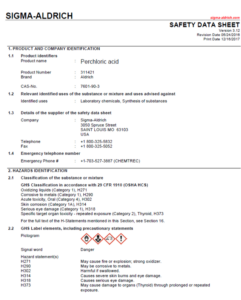 |
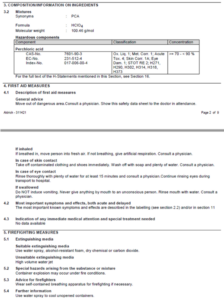 |
NFPA 704 Fire Diamond
The NFPA 704 Fire Diamond is a standard system for the identification of hazards of materials. It is used, primarily by emergency personnel, to quickly and easily identify the dangers posed by hazardous materials. You will often see this NFPA Fire Diamond on individual chemical containers, or chemical storage areas.
The four divisions are color coded, and rated on a scale from 0 (No Hazard) to 4 (Highest Hazard).
- BLUE: Health Hazard
- RED: Flammability Hazard
- YELLOW: Instability Hazard
- WHITE: Special Hazard (Alkaline, Acidic, Corrosive, Oxidizing, Radioactive, Water Reactive)
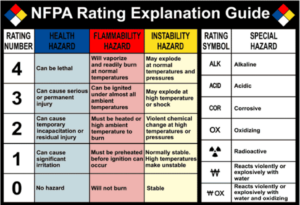 |
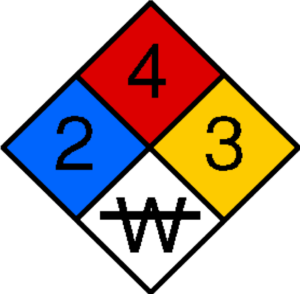 |
Module 5: Safe Chemical Handling
Watch
Read
Safe Chemical Handling
Working safely with chemicals begins with understanding three simple steps: plan ahead, protect yourself, and prepare for emergencies. This module will walk through each of these guidelines.
Step 1: Plan Ahead
Planning ahead is the first step to working safely in a lab. Identifying hazards and assessing risk for your process, is critical in mitigating risk in the lab.
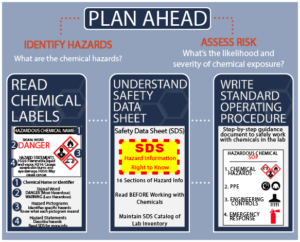
When working with chemicals, identifying the hazards of your chemicals usually begins with reading and understanding chemical labels and safety data sheets. It’s important not only to identify the hazards, but also understand or assess the risk of these chemical hazards. Risk is simply how likely you are to be harmed by a certain chemical hazard in the lab. Identifying hazards and assessing risk of these hazards is the first step in working safely with chemicals.
Step 2: Protect Yourself
Protecting yourself in the lab requires you to combine the right engineering controls (lab hoods, local exhaust ventilation, gloveboxes, etc.), administrative controls (training and procedures) and personal protective equipment (lab coat, safety glasses, gloves, etc…).
Engineering Controls:
Engineering controls protect lab users by removing hazardous conditions, or by placing a barrier between the lab user and the hazard. Examples include local exhaust vents and lab hoods to capture and remove airborne contaminants, and machine guards to protect lab users from moving parts on a machine.
Administrative Controls:
Administrative controls are changes in training, policies, rules, and written procedures to lessen the threat of a hazard to a lab worker. Administrative controls (e.g. standard operating procedures, training, supervision, safe lab rules) should describe the way chemical handling in the lab is done safely, and include measures to reduce the risk of chemical exposure.
Make sure to adhere to the following administrative controls:
- Ensure you have proper training to handle chemicals safely in the lab,
- Restrict access to areas where hazardous chemicals are used,
- Post signs and warnings to identify chemical hazards in your lab,
- Always follow lab rules and guidelines for safe lab practices.
Personal Protective Equipment:
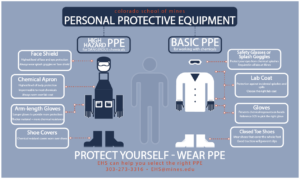
The right PPE depends on what chemicals or equipment you are using. For lower hazard chemicals (e.g. salt solutions, dilute acids and bases, small volumes of solvents) basic PPE is required. Basic PPE includes: safety glasses or goggles, lab coat, gloves, long pants and closed toe shoes.
Working with higher hazard chemicals (e.g. concentrated acids and bases, water reactive or pyrophoric chemicals, or other particularly hazardous chemicals) requires additional PPE. Face shields offer the highest level of face and eye protection when worn in combination with splash goggles. Chemical resistant aprons, arm length gloves, and shoe covers can be used to prevent exposure to many chemicals. Higher hazard PPE is often worn when working with large volumes of chemicals, or even small volumes of highly hazardous chemicals.
Step 3: Prepare for Emergencies
Working with chemicals can often be hazardous, and sometimes emergencies occur in the lab. It is your responsibility to be prepared to respond to emergencies in your lab.

More information on emergency response, and a list of important emergency contact information can be found at Mines EHS Emergency Webpage.
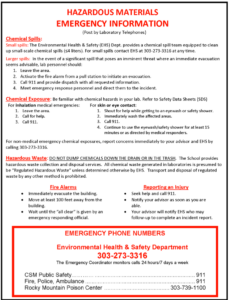
Chemical Storage
- Always segregate and store chemicals based on hazard class.
- The most common hazard classes are: flammables, acids, bases, oxidizers, toxics, compressed gases, and water reactive
- Store each hazard class in separate storage areas
- Label storage areas with the hazard class found in that area
- DO NOT store chemicals in a sink.
- DO NOT store chemicals alphabetically, unless they are compatible!
Flammable Material Storage
- Never store flammables with oxidizers or any other hazard class.
- Store flammable liquids in a grounded, metal flammable storage cabinet.
- Refrigerators used to store flammables must be rated for flammable storage
- Do not use domestic style refrigerators to store flammables.
- Domestic fridges may explode due to build up of vapors.
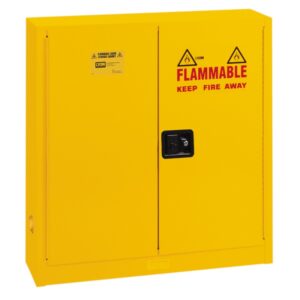 |
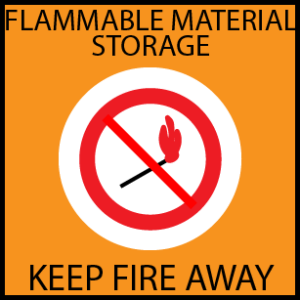 |
Module 6: Hazardous Waste Definitions
Read
Resource Conservation and Recovery Act (RCRA)
The Resource Conservation and Recovery Act (RCRA) gives the Environmental Protection Agency (EPA) the authority to regulate hazardous waste from the “Cradle to the Grave”. This includes the generation, storage, transportation, treatment, and disposal of hazardous waste.
RCRA Goals:
- Protect human health and the environment from hazards posed by chemical waste generation, storage, and disposal.
- Conserve energy and natural resources through waste recycling and recovery.
- Reduce or eliminate the amount of waste generated.
- Ensure wastes are managed in a manner that is protective to human health and the environment.
Why Do We Need RCRA?
The Resource Conservation and Recovery Act clearly outlines how to store, treat and dispose of hazardous waste. Up until the enactment of RCRA in 1976, hazardous wastes were not always managed appropriately, as you can see in the pictures below.
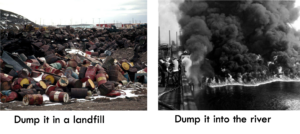
Hazardous Waste Definitions
According to the EPA, a waste is hazardous if it can cause harm to human health and/or to the environment when handled improperly. Waste is hazardous under RCRA based on two main criteria:
- If the waste is an EPA Listed Hazardous Waste or
- A Characteristic Hazardous Waste
For the purposes of this training, we are only concerned with Characteristic Hazardous Waste.
Characteristic Hazardous Waste
Characteristic Hazardous Wastes are wastes that exhibit any one or more of the following characteristic properties: ignitable, corrosive, reactive or toxic.
1. Ignitable

-
- Liquid waste with a flash point < 140°F
- Examples: Methanol, Isopropanol, Xylene
- Oxidizing waste (liquid or solid)
- Examples: Nitrates, Permanganates, Hydrogen Peroxide
- Ignitable compressed gas
- Examples: Propane, Acetylene, Hydrogen
- Solids capable of igniting by absorption of moisture, spontaneous chemical change, or friction
- Examples: Sodium Metal, Calcium Metal, Lithium Aluminum Hydride, Picric Acid, Fine Metal Powders
- Liquid waste with a flash point < 140°F
-
Corrosive
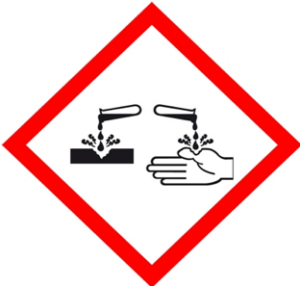
-
- Liquid waste with a pH < 2 or pH > 12.5
- Acidic (pH<2): Hydrochloric, Hydrofluoric, Nitric and Acetic Acid
- Caustic (pH>12.5): Sodium Hydroxide, Potassium Hydroxide
- Liquid waste with a pH < 2 or pH > 12.5
3. Reactive
-
- Normally unstable and undergoes violent change
- Air (pyrophoric) or water reactive
- Aluminum Chloride, Sodium Metal, Organometallic Compounds
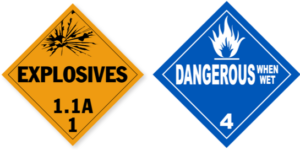
- Aluminum Chloride, Sodium Metal, Organometallic Compounds
- Explosive or forms an explosive mixture with water
- Picric Acid
- Liberates cyanide or sulfide gas when exposed to acid
- Sodium Cyanide, Sodium Sulfide
4. Toxic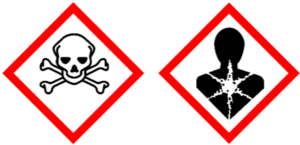
-
-
-
- Toxic wastes are regulated based on contaminant concentration. In general, waste containing the following contaminants are considered toxic hazardous wastes:
- Heavy Metals
- As, Ba, Cd, Cr, Pb, Hg, Se, Ag
- Organic Compounds
- Benzene, MEK and chlorinated solvents
-
-
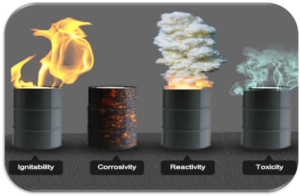
Module 7: Hazardous Waste Management
Read
Satellite Accumulation Areas (SAA)
Satellite Accumulation Areas (SAAs) are temporary waste accumulation areas in your lab at or near the point of waste generation. A SAA is simply the location in your lab where you store your waste.
Guidelines:

- Laboratory hazardous waste must be stored in a SAA in your lab.
- SAAs can be located in/on:
- Lab hoods
- Floors
- Chemical storage cabinets
Satellite Accumulation Areas (SAAs) Must:
- Use appropriate and compatible waste containers
- Be properly labeled
- Have containers closed except when adding waste
- Have incompatible wastes segregated
- Have waste in secondary containment
- Be inspected weekly
SAA Requirement – Use Appropriate and Compatible Waste Containers
Use containers that are compatible with your chemical waste:
- Glass – organic acids, oxidizers, other organics
- Plastic – mineral acids (HCl, HF, …), bases, mercury
- Gases – original container
Solid and Liquid Waste:
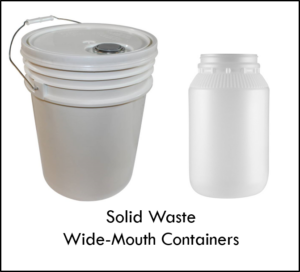
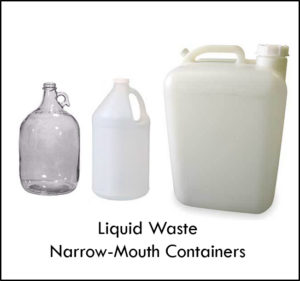
The figure above shows appropriate waste containers for solid and liquid hazardous waste. Solid waste should be collected in wide mouth containers, while liquid waste should be collected in narrow-mouth containers.
DO NOT Store Hazardous Waste in Food and Beverage Containers:
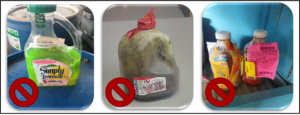
SAA Requirement – Properly Label Every Waste Container
A waste label must be attached to the waste container the first time you add waste to the container. The label must be complete, and have all fields filled out. Be as descriptive as you can. Do not use chemical abbreviations.
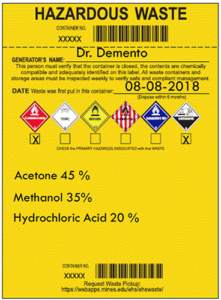
- Attach a label when you first add waste
- Unlabeled containers result in unknown wastes
- Label must be complete
- Include your name, date and list chemical constituents
- Identify constituents and concentrations
- Estimated concentrations are fine
- Include pH if you are able to
- Use chemical names – not formulas or abbreviations
- Identify the hazard(s) associated with your waste by placing an “X” under each applicable hazard
How do I label non-hazardous waste?
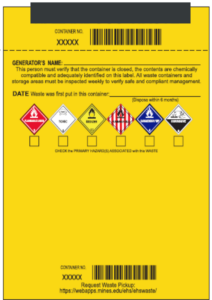
Non-hazardous waste (which we will discuss more in the next Module) still needs to be stored and labelled properly. For these waste streams, please deface the label’s heading “Hazardous Waste” with a marker, like you see in the picture to the right.
Types of Non-Hazardous Waste
- Broken glass
- Empty containers
- Sharps
- Electronics
- Batteries
Attaching Waste Labels
When you attach the yellow label to your waste containers, make sure to only peel the top inch of adhesive on the back of the label (see picture below).
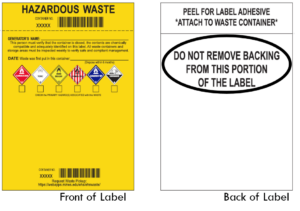
SAA Requirement – Waste Container Condition
All of the waste containers in your satellite accumulation area must be in good condition. Make sure to follow these guidelines:
- Waste containers must be closed except when actively adding waste.
- Make sure your waste mixture does not pressurize.
- Watch for leaks.
- Do not overfill waste containers – Leave at least 2 inches of head space in all waste containers.
Funnels
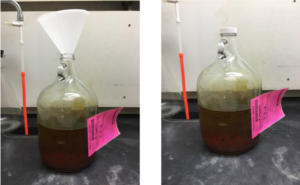
- Waste containers must be closed with a lid except when actively adding waste.
- DO NOT leave funnels in waste containers. Funnels are not acceptable container closures.
- ALWAYS replace the lid after adding waste.
Pressure Generating Mixtures
Some chemical mixtures are notorious for generating pressure in sealed containers.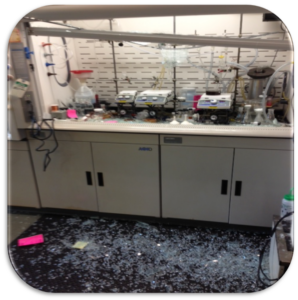
-
- Piranha Solution
- Hydrogen Peroxide and Sulfuric Acid
- Nital Solution
- Nitric Acid and Methanol or Ethanol
- Aqua Regia
- Hydrochloric Acid and Nitric Acid
- Piranha Solution
The image to the right shows a lab hood that shattered when a waste container with nital solution pressurized and exploded in the hood.
Whenever using pressure generating mixtures:
-
- Wear personal protective equipment (PPE)
- Always work in a lab hood and lower hood sash
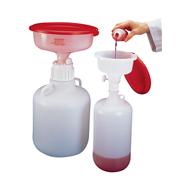
- Dilute the waste with 50% water (always add acid to water)
- Allow time for neutralization and gas evolution prior to submission to EHS
- Use a pressure relieving lid when sealing containers
- Waste that has the potential to generate pressure must be stored using a pressure relieving funnel (see picture to right)
- Pressure relieving funnels have a lid, and can be used as a lid
SAA Requirement – Segregate Incompatible Materials
Another SAA requirement is to segregate incompatible waste containers.
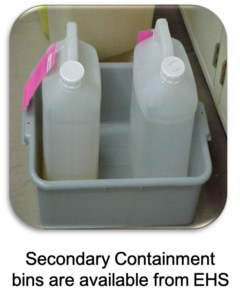
- All hazardous waste containers should be stored in secondary containment to capture any spills or leaks from the primary waste containers.
- Use secondary containment bins to separate incompatible wastes (see image to right).
- Use secondary containment bins for all waste stored in SAAs.
- Secondary containment bins are available from EHS at no cost.
Segregating Chemical Waste
It is important to segregate incompatible waste during storage to eliminate dangerous chemical reactions. The following guidelines must be followed when storing your waste:
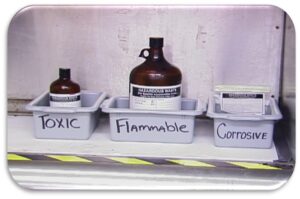
- Separate all incompatible chemical waste, for example:
- Separate acids from bases
- Separate flammables and organics from oxidizing materials
- Separate cyanide salts from acids
Sharps
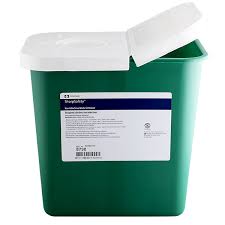
- Sharps (needles, scalpels, razors, etc…) must be disposed of in a sharps container.
- Green, puncture-resistant plastic containers.
- Store sharps waste separate from broken glass, and all other waste.
Laboratory Glass
- Collect in plastic container with lid or cardboard container.
Radioactive Waste
- Separate from everything else. Do not mix radioactive waste with chemical or biological wastes.
- Requires Radiation Safety Training
Biohazard Waste
- Collected in red biohazard waste containers.
- Requires Biosafety Training
Waste Minimization
Mines is proactive in minimizing the generation of hazardous waste on campus. You can help minimize chemical waste by:
- Using less hazardous or non-hazardous alternative products (Green Chemistry)
- Using small or micro analytical lab techniques
- Avoiding spills
- Avoiding unknown waste containers by labeling all waste and chemical containers
Waste Water Permit
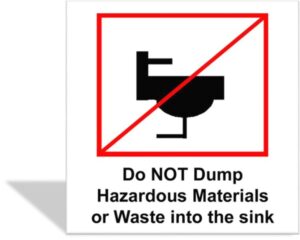
As part of Mines’ Waste Water Permit with the City of Golden, EHS monitors sewer outfalls for every building on campus. It is important these outfalls do not contain any chemicals.
NEVER pour any hazardous materials down the drain!
City of Golden & Mines Stormwater Plan
Our stormwater plan mostly applies to Facilities Maintenance, but you can help eliminate hazardous item from enter the stormwater system. A few items that can help are:
- Maintaining automobiles
- Reporting spills or leaks
- Properly disposing of trash
- Recycling engine oil
- Do not dump anything down the storm drain
Module 8: Other Lab Hazards
Watch
Read
Compressed Gases
Gas cylinders store gases at high pressure. Gas cylinders can be hazardous due to both their physical and chemical characteristics. Laboratories at Mines use a wide variety of compressed gases including: flammable, toxic, corrosive and oxidizing gases. It is always important to understand the chemical hazards of the gas you are using in the lab.
Gas cylinders can be bulky, heavy, and awkward to handle. Cylinders can tip over quite easily, and may cause harm to you or your lab. Cylinders require special care in transport and storage in your lab.
Transporting Gas Cylinders
Safely Store Gas Cylinder in Your Lab
|
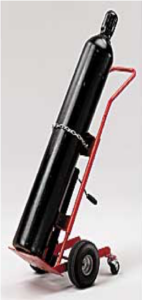 |
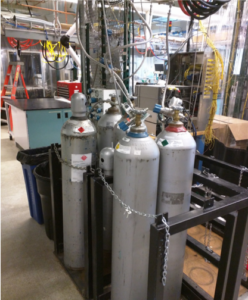 |
Cryogenic Materials
Cryogenic materials like: liquid nitrogen, liquid helium, and liquid argon are common hazards in the lab. Cryogenic liquids are extremely cold and have boiling points less than 238 degrees F. Be sure to always wear PPE when transferring, pouring, or working with cryogenic materials (insulated cryogen gloves, goggles, face shield, long pants and sleeves).
Cryogenic liquids boil rapidly at room temperature. A very small amount of a liquid cryogen will evaporate into a large amount of gas. It is important to never work in a confined space, or ride in an elevator with liquid cryogens because as these liquids boil into a gaseous phase, they may displace breathable oxygen in a confined space.
Even liquid cryogen cylinders used to transport liquid cryogens (see the picture in below) vent periodically to relieve pressure. It is unsafe to work in a confined space with a with liquid cryogen.
Extremely ColdPersonal Protective Equipment:
Asphyxiation HazardLike compressed gases, cryogens expand into a large volume of gas and may displace breathable oxygen!
|
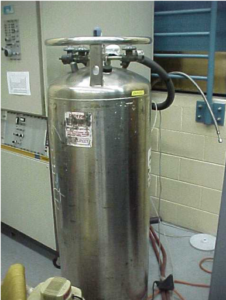 |
Please confirm with the lab manager if you intend to work with any of these additional hazards:
-
Radioactive Material
-
Lasers
-
Biohazardous Materials
-
Respirators
